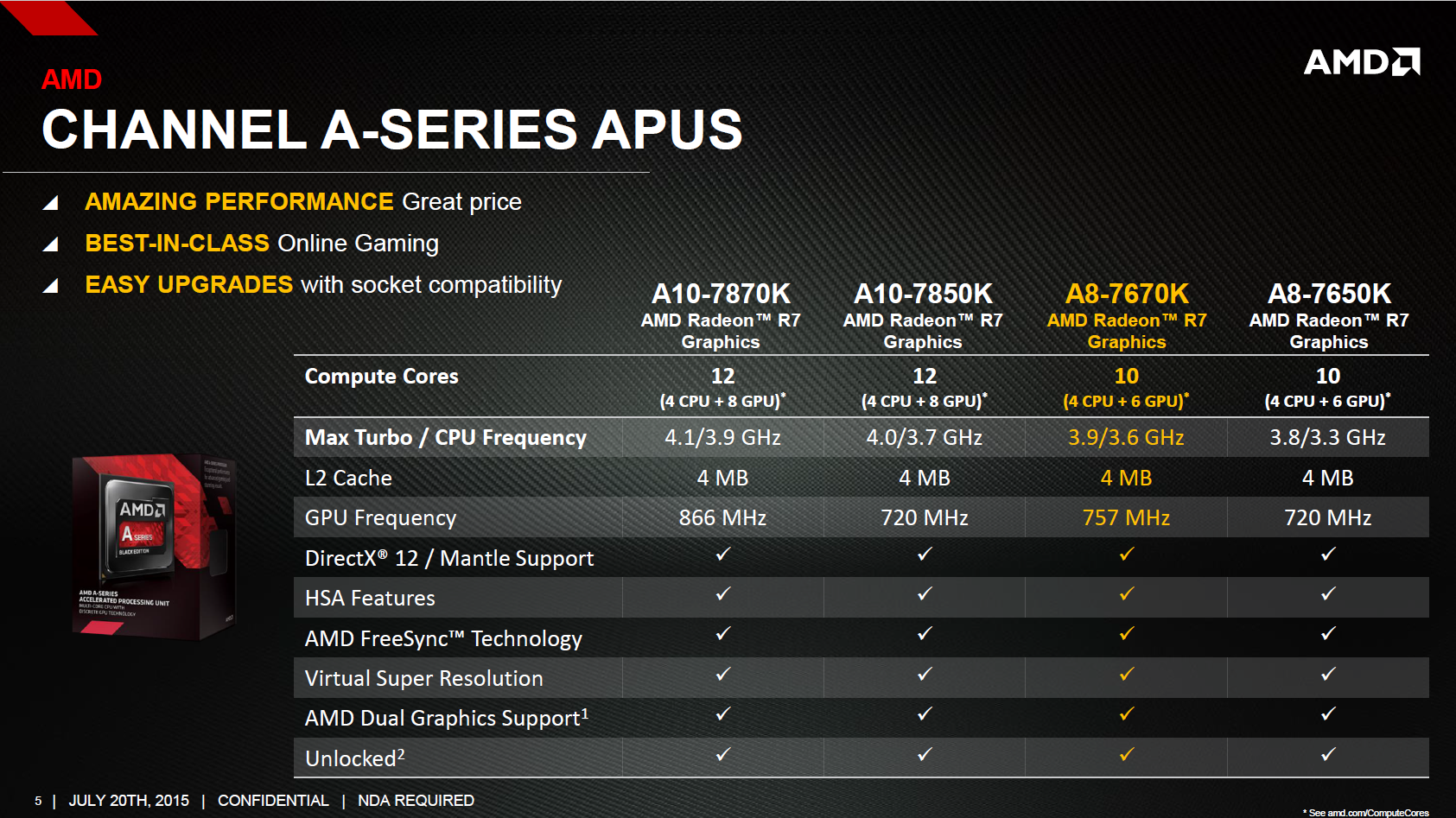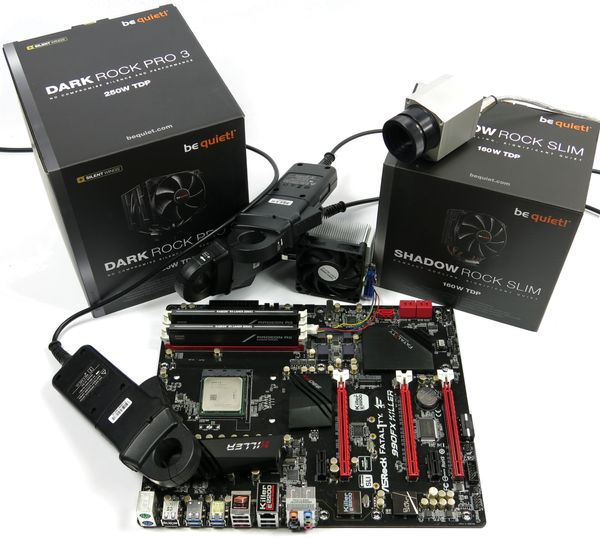CPU Overclocking Guide: How (and Why) to Tweak Your Processor
Learn the pros and cons of overclocking your CPU, the physics behind changing your clock rate and the basics of overclocking an Intel or AMD processor.
AMD Processors
AMD lags behind Intel when it comes to CPU performance. And with its somewhat chaotic code names (Kaveri is a river in India, Deneb is a star-system and/or plot-element in the late Anne McCaffrey’s T&T novels, Heka is an Egyptian deity) and name retractions (Godavari disappeared, becoming a Kaveri refresh), coupled with the number of CPU models and re-releases out there, it can become hard to keep track of the company's unique configurations and their overclocking potential. Despite AMD not showing up in online benchmark comparisons as often as it used to, many enthusiasts still stand by its aging hardware.
AMD processors are typically cheaper than their Core counterparts, and nearly all of the company's SKUs are multiplier-unlocked. We're only listing the current-gen performance-oriented desktop chips: the FX family (Piledriver architecture, code-named Vishera) and the Kaveri-refresh A10 APU family. The latter includes integrated Radeon graphics, and is aimed at home users and low- to mid-range gamers, whereas the Vishera-based FX CPUs are geared towards overclocking and performance-oriented desktops, as evidenced by their higher TDPs.
Current-Generation AMD Performance Processors
| Model Number | Cores | Frequency | L2/L3 Cache | TDP |
|---|---|---|---|---|
| FX-8370 Wraith cooler | 8 | 4.0/4.3 GHz | 8MB/8MB | 125W |
| FX-8350 Wraith cooler | 8 | 4.0/4.1 GHz | 8MB/8MB | 125W |
| FX-6350 Wraith cooler | 8 | 3.9 GHz | 8MB/8MB | 125W |
| FX-9590* | 8 | 4.7/5.0 GHz | 8MB/8MB | 220W |
| FX-9370* | 8 | 4.4/4.7 GHz | 8MB/8MB | 220W |
| FX-8370 | 8 | 4.0/4.3 GHz | 8MB/8MB | 125W |
| FX-8370E | 8 | 3.3/4.3 GHz | 8MB/8MB | 95W |
| FX-8350 | 8 | 4.0/4.2 GHz | 8MB/8MB | 125W |
| FX-8320 | 8 | 3.5/4.0 GHz | 8MB/8MB | 125W |
| FX-8320E | 8 | 3.2/4.0 GHz | 8MB/8MB | 95W |
| FX-6350 | 6 | 3.9/4.2 GHz | 6MB/8MB | 125W |
| FX-6300 | 6 | 3.5/4.1 GHz | 6MB/8MB | 95W |
| FX-6200 | 6 | 3.8/4.1 GHz | 6MB/8MB | 125W |
| FX-6100 | 6 | 3.3/3.9 GHz | 6MB/8MB | 95W |
| FX-4350 | 4 | 4.2/4.3 GHz | 4MB/8MB | 125W |
| FX-4300 | 4 | 3.8/4.0 GHz | 4MB/4MB | 95W |
| FX-4130 | 4 | 3.8/3.9 Ghz | 4MB/4MB | 125W |
| FX-4100 | 4 | 3.6/3.8 Ghz | 4MB/8MB | 95W |
| A10-7890K Wraith cooler | 12 (4 CPU + 8 GPU) | 4.3 GHz/ 4.1 GHz | 4MB | 95W |
| A10-7870K | 12 (4 CPU + 8 GPU) | 4.1 GHz/ 3.9 GHz | 4MB | 95W |
| A10-7860K | 12 (4 CPU + 8 GPU) | 4.0 GHz/ 3.6 GHz | 4MB | 45-65W |
| A8-7670K | 10 (4 CPU + 6 GPU) | 3.9 GHz/ 3.6 GHz | 4MB | 95W |
| A8-7650K | 10 (4 CPU + 6 GPU) | 3.8 GHz/ 3.3 GHz | 4MB | 95W |
| A10-7870K13 | 12 (4 CPU + 8GPU) | 4.1 GHz/ 3.9 GHz | 4 MB | 95W |
| A10-7850K13 | 13 (4 CPU + 8GPU) | 4.0 GHz/3.7 GHz | 4MB | 95W |
| A10-7800 | 12 (4 CPU + 8GPU) | 3.9 GHz/3.5 GHz | 4MB | 65W |
| A10-7700K13 | 10 (4 CPU + 6 GPU) | 3.8 GHz/3.4 GHz | 4MB | 95W |
| A8-7670K13 | 10 (4 CPU + 6 GPU) ³ | 3.9 GHz/3.6 GHz | 4MB | 95W |
| A8-7650K13 | 10 (4 CPU + 6 GPU)* | 3.8 GHz/3.3 GHz | 4MB | 95W |
| A8-7600 | 10 (4 CPU + 6GPU) | 3.8 GHz/3.1 GHz | 4MB | 65W |
| A6-7470K | 6 (2 CPU + 4 GPU) | 4.0 GHz/ 3.7 GHz | 1MB | 65W |
| A6-7400K13 | 6 (2 CPU + 4 GPU) | 3.9 GHz/3.5 GHz | 1MB | 65W |
In order to overclock AMD CPUs successfully, motherboard capabilities are critical; winning the silicon lottery won’t mean anything if your board's components are not up to the task, while a less-than-stellar chip can still be compensated for by a high-quality motherboard.
As AMD usually has many more user-settable voltage values compared to Intel, the CPU’s power and thermal datasheet should be on hand while attempting to modify any of the more advanced voltage values—each CPU has defaults for each of the configurable voltages, and these should be used as a baseline and guide. In addition to the most important voltages listed earlier, the following list of variables is not comprehensive, and does not apply to every processor; the problem of defining exactly what voltages mean becomes more complex because each motherboard manufacturer labels certain settings differently. In particular, voltages with “NB” in the parameter name could mean a number of different things, including the voltage used by the CPU’s integrated northbridge controllers or the motherboard chipset.
- VDDA: The AMD version of the Phase-Locked Loop voltage.
- NB/HT Voltage: The voltage used by the HyperTransport interface, also called HT Voltage or VLDT.
- VDP: This is the voltage supplied to the integrated graphics controller (only for AMD APUs). Like Intel-based motherboards, this may be listed under a variety of names, including “Integrated Graphics Voltage”.
- PCI Express Voltage: Also only on AMD APUs, this voltage feeds the integrated PCI Express controller.
- VDDIO: This is the voltage supplied to the memory buss, and can be called DRAM Voltage, DIMM voltage, Memory Voltage, etc. The default values of this voltage depend on the RAM, not the CPU.
- VTT: Completely different from the VTT voltage on Intel processors, this voltage feeds the termination loop for the memory, and is ½ of VDDIO by default.
- MEMVREF: This is a reference voltage threshold for the CPU; voltage levels below this threshold are referenced as 0, and voltage levels higher are referenced as 1. This voltage can be controlled on certain motherboards using the VREFCA and VREFDQ voltage as multipliers of VDDIO.
Overclocking AMD Processors
Though early APU overclockers reported stability issues with firmware-based overclocking, enough time has gone by that the choice between AMD’s Overdrive software, firmware overclocking, and third-party utilities is mostly a matter of personal taste.
Overclocking an AMD processor is similar to overclocking an Intel processor, with differences in some terminology and (on the whole) a deeper set of tunable variables. Heat, as always, is a problem—the Kaveri-refresh chips (A10) do best with temperatures below 70 °C, and overclocks max out around 4.8 GHz. BCLK is set to a default 100 MHz, and base frequencies beyond 105/106 MHz are typically unstable. The integrated memory controller also runs into some problems; members of the community have reported that DRAM frequencies set to “Auto” don’t often work well, and need to be tuned manually. Additional stability can be eked out of the system by adjusting northbridge frequencies.
Vishera (FX) prefers temperatures around 60 to 70 °C, generally lower than Kaveri-refresh chips. The BCLK can also be driven much higher, over 220 MHz, before motherboard components start to fail. CPU frequencies (though not necessarily stability) can also be improved slightly by increasing the northbridge and HyperTransport speeds, depending on what the bottlenecks are.
Get Tom's Hardware's best news and in-depth reviews, straight to your inbox.
AMD Overdrive
AMD’s own desktop software suite, Overdrive, offers benchmarking utilities, stress and stability tests, and overclocking controls. A much deeper and finer level of tuning can be achieved via BIOS overclocking, but Overdrive does not require a reboot for changes to be applied. It can also provide quick stability and performance checks, along with incremental, minor changes between more intensive firmware-based modifications. Further, AMD provides a complete guide to using the Overdrive utility.
-
rush21hit Look at the voltage setting on those world records. Lots of LN2 involved here.Reply
Speaking as a former user of Q6600 @3.0 (Corsair Hydro series were non-existent back then) and i7 920 @2.8. Small OC, I know. Since I want my motherboard not get fried.
Motherboard gets the most hammering in OC. Even the best of the best sometimes failed. Those capacitors can only hold so much. I just want to ensure it also last. Heck, even in normal use, motherboard tends to fail long before any other parts does. -
Calculatron Ever since the articles on the "E" series of the FX-line-up, I've tried to take efficiency into account. I run a mild overclock of 4.0ghz with just under 1.2V on my FX-8320. I can achieve a 4.7ghz overclock, but I just don't think that the performance gains are worth all the extra heat and stress on the components.Reply -
Nuckles_56 There's a typo in the table of record speeds for the CPUs and the respective voltages, as there is no way that the i7 860 got to that speed at 1.152VReply -
SinxarKnights Reply18275176 said:There's a typo in the table of record speeds for the CPUs and the respective voltages, as there is no way that the i7 860 got to that speed at 1.152V
http://valid.x86.fr/xuxjnn look for yourself. I suspect there was an error reading the voltage but I do not know, CPU-Z calls it valid though. -
TexelTechnologies Its not that complicated but then again I am always surprised by how dumb people are.Reply -
Murdock4321 Overclocking used to be pretty complicated and take some trial and error. With all these new processors and new bios', its really pretty easy. I'm still rocking an i7 930 @ 2.85ghz which is rock solid and has lasted me since 2010Reply -
jtd871 How about an underclocking/undervolting guide for those that want efficiency rather than performance?Reply -
anbello262 Well, isn't the procedure exactly the same, just lowering mult and volt instead of rising it? The stability concern (freq/volts) and the iterative methodology is the same, right?Reply


